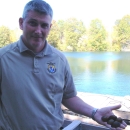The relationship between freshwater mussel density and heavy metal concentrations in river sediments was investigated in the Big River downstream of areas with past mineral mining. Quantitative mussel surveys were conducted and river sediments were analyzed for grain size and concentrations of lead (Pb), cadmium (Cd), and zinc (Zn) at 18 sites selected between river kilometer (RK) 2.5 and 127. Tissue samples were also collected of Asian clams (Corbicula fluminea) to determine body burdens of heavy metals and verify exposure of bivalves. Mussel density negatively corresponded to elevated concentrations of sediment Pb downstream of mining operations. A significant decrease in mussel density was observed downstream of mining sites between RK 113.5 and 67.5, where Pb concentrations were greater than the Probable Effects Concentration (PEC) of 128 mg/kg. As Pb concentrations decreased to near the PEC at RK 47.5 and further downstream, mussel density increased at most sites. While mussel densities recovered at RK 47, this did not correspond with a recovery of mussel richness until RK 16.5 where the mussel fauna is comparable to reference streams. Corbicula fluminea were found to be exposed to heavy metals, and tissue Pb concentrations were correlated with mussel density and sediment Pb concentrations. Lead concentrations in C. fluminea tissue correlated with Pb in sediment and mussel density more strongly than similar comparisons between Zn and Cd concentrations in tissues. Mussel population metrics were not correlated with sediment grain size and other substrate metrics. Comparisons of mussel species diversity using available data from other similar rivers in Missouri indicated a 70 to 75 percent decline of mussels in Pb contaminated areas of the Big River.
Publication date
Type of document
Report
Facility
Program
FWS and DOI Region(s)






